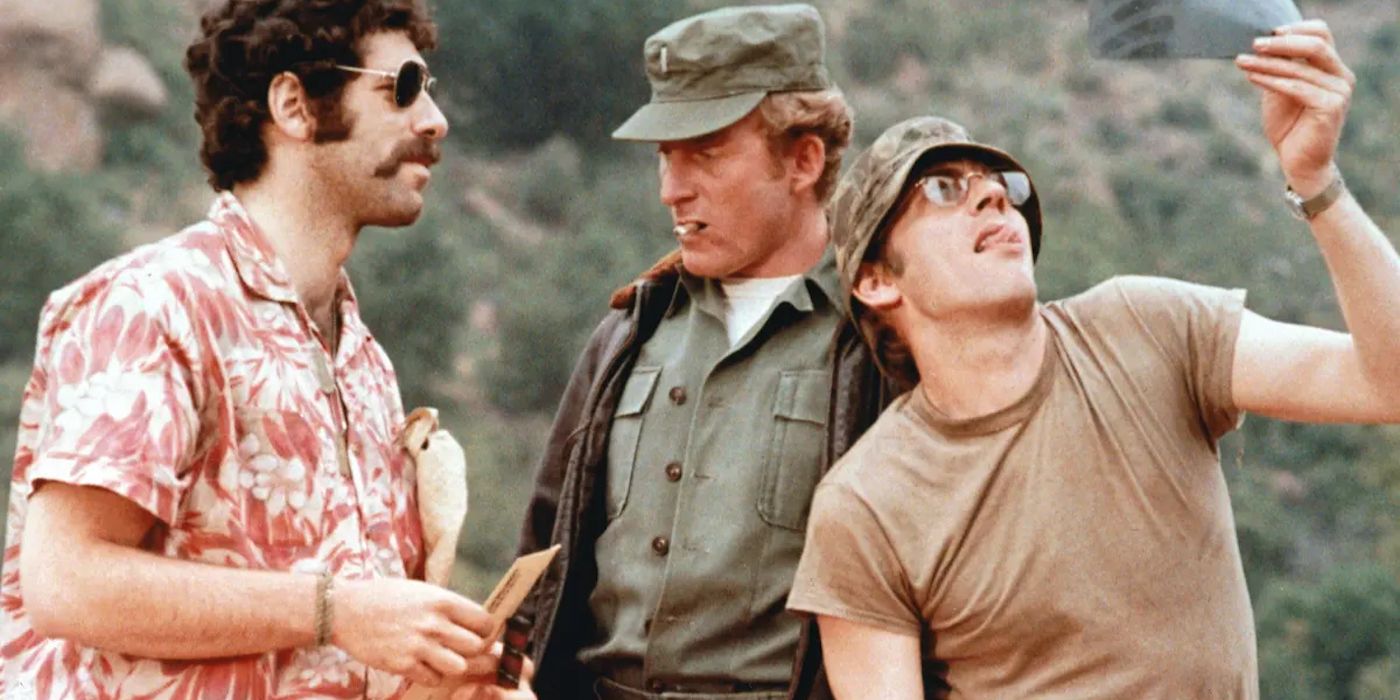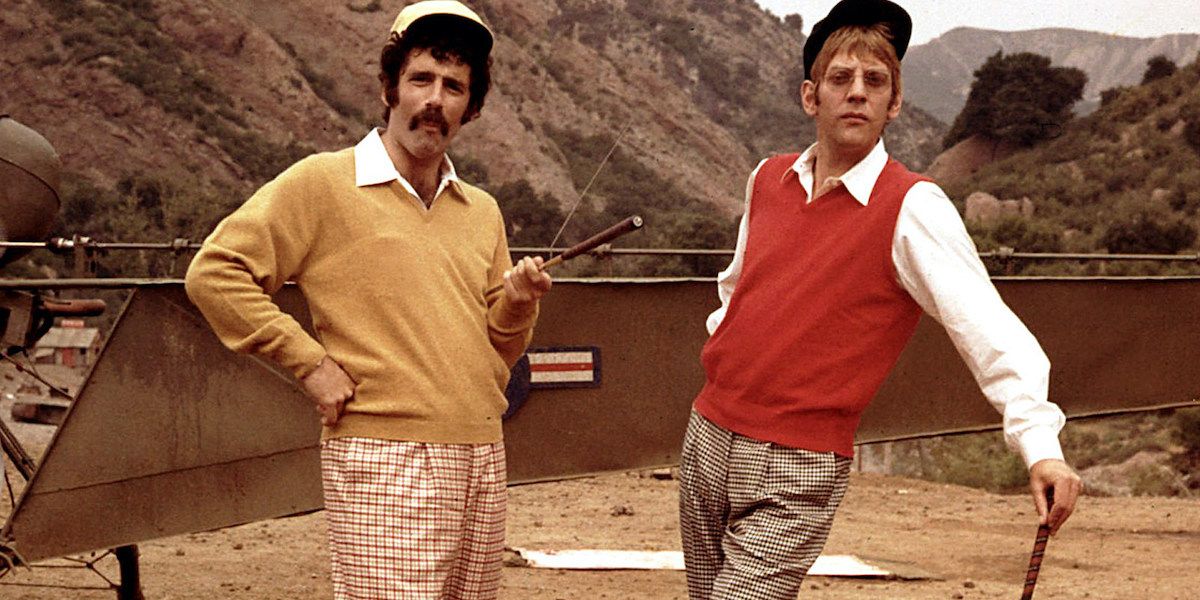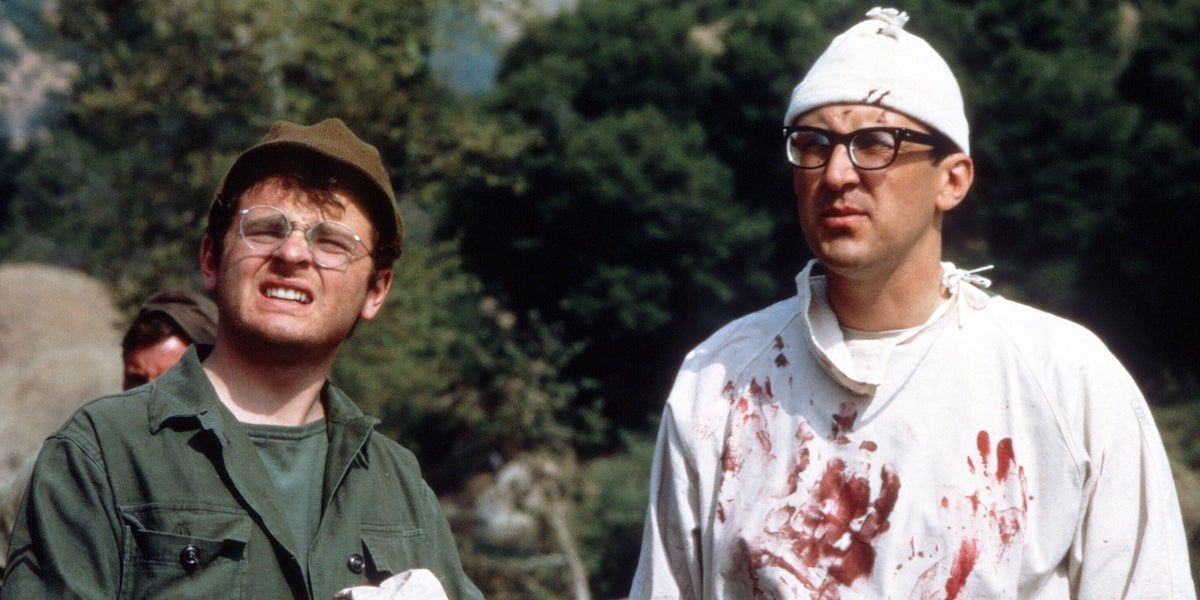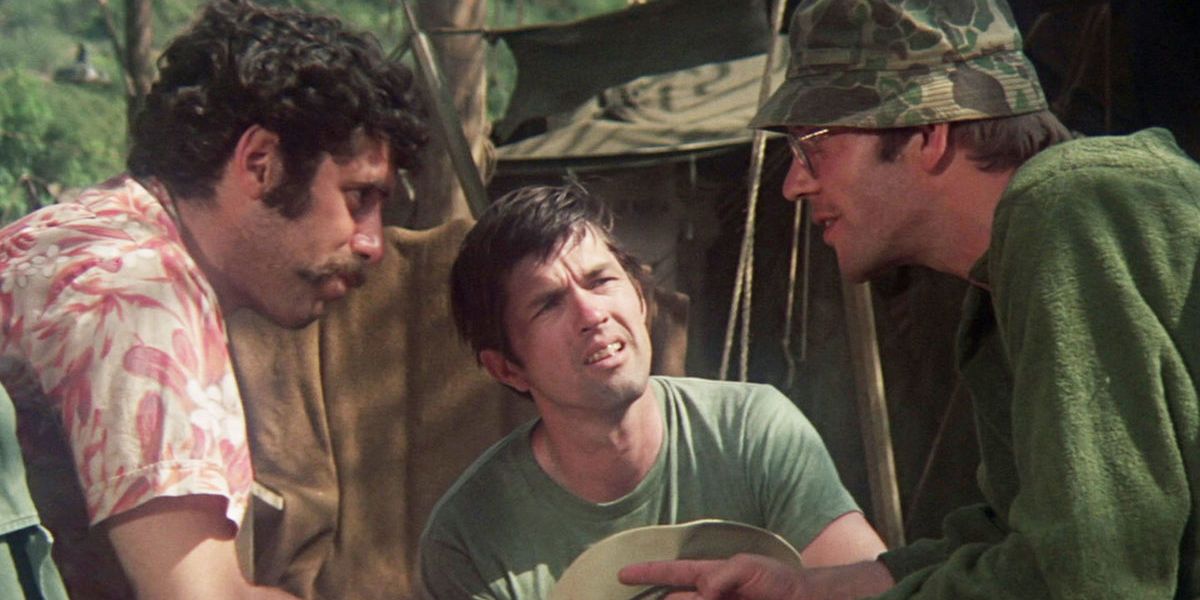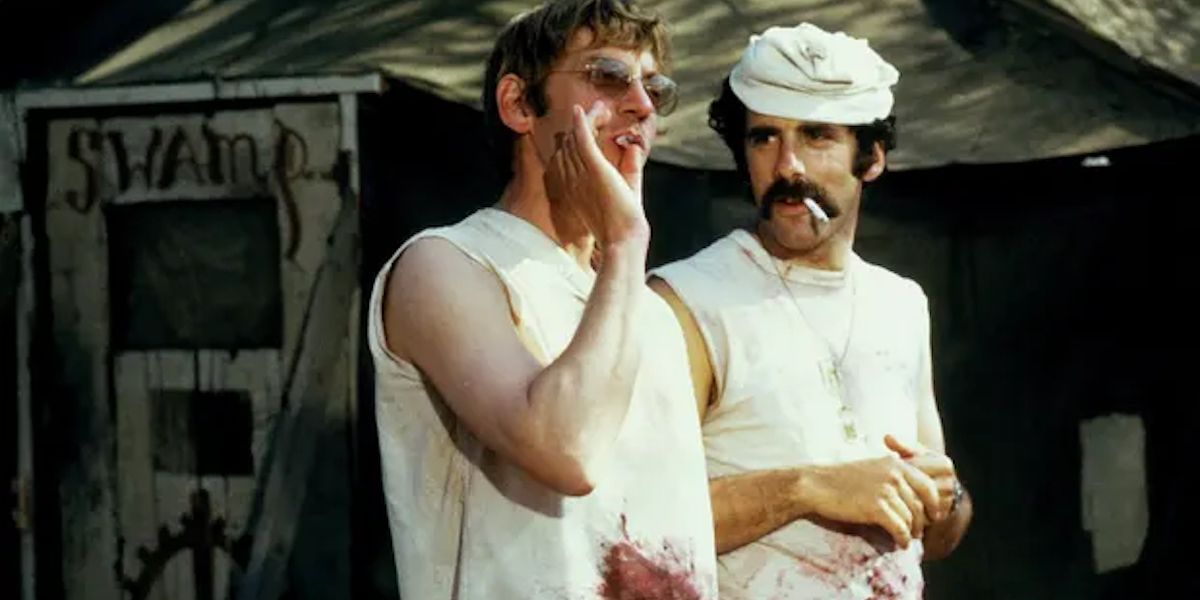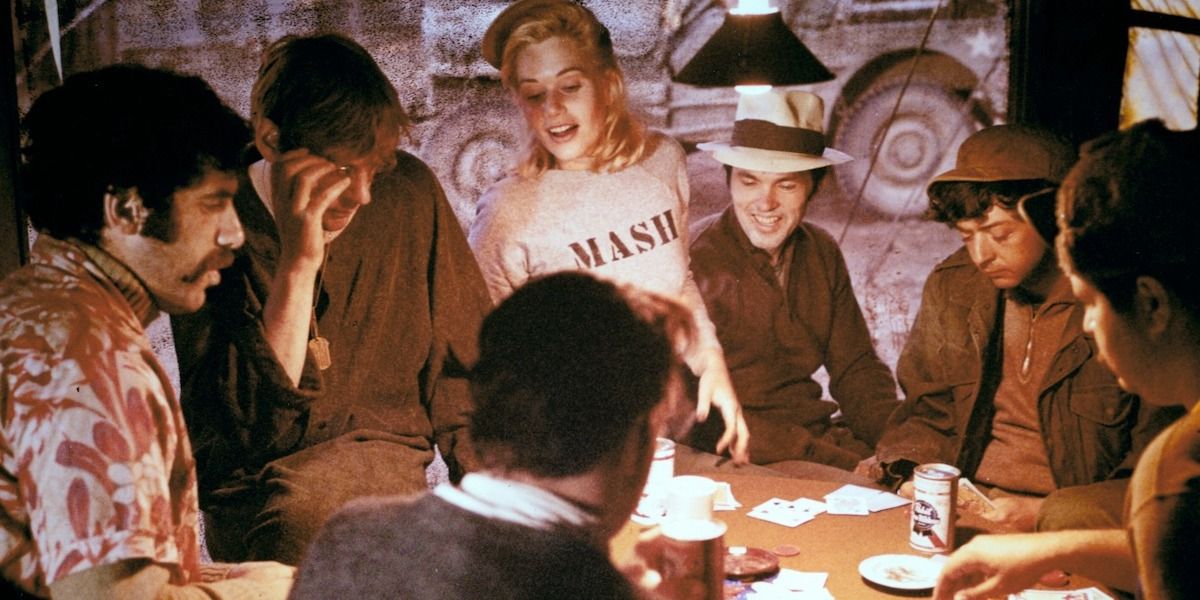Released in 1970, MASH was director Robert Altman’s breakthrough movie – a commercial and critical hit, winning the Palme d’Or at Cannes. It spawned one of the most successful sitcoms of the ‘70s, with the television version continuing the focus on the pranks and rivalry between characters on a mobile army hospital during the Korean War. However, the original film is a darker affair. A mix of anti-war movie and sex comedy, MASH’s attitude is questionable on many levels, although Altman’s direction still shines. With a documentary-style take on the impact of war and innovative sound design, it anticipated greater work from Altman and inspired a grittier wave of films to come.
What Is MASH About?
During the Korean War, Captain “Hawkeye” Pierce (Donald Sutherland) is a non-conformist surgeon assigned to the 4077th Mobile Army Surgical Hospital (or MASH). Teaming up with fellow doctors, “Trapper John” McIntyre (Elliot Gould) and “Duke” Forrest (Tom Skerritt), he engineers various pranks and sexual escapades alongside the business of treating wounded soldiers coming through the base.
MASH is deliberately plotless, although there’s a kind of structure as its comedy vignettes alternate with graphic scenes set in the surgical tent. Anytime the film threatens to take on some meaningful storyline, such as Hawkeye’s effort to save Korean teenager, Ho-Jon (Kim Atwood), from conscription, the story moves on to the next incident. There’s a through-line about the main characters battling military authority, but the film’s big showdown is a chaotic football match where the underdog MASH crew takes on a general’s team and wins. It anticipates National Lampoon’s Animal House in that respect (the Deltas from that movie are just the MASH boys in a different setting). Meanwhile, it’s a sex comedy more explicit than the tame offerings of the ‘60s, prefiguring Porky’s and even Fast Times at Ridgemont High – episodic comedies where character study trumps plot.
MASH Is a War Film
It's also a war film, released at the height of the Vietnam War. MASH's Korean War setting is an obvious stand-in for that conflict, with the anti-establishment stance of the main characters embodying the counter-culture ideals of the ‘60s rather than the ‘50s. However, Altman avoids any overt anti-war message, giving the audience credit that it’s clear enough from the scenes of amputations and arteries spurting blood. When Hawkeye meets a documentary filmmaker on the streets of Seoul and sends a message to the folks back home, all he says is “Hi, dad.” The surgical scenes are realistic for the time – perhaps more so than any previous American war movie. There are no battles in MASH (aside from the sublimated warfare between various factions on the base) and the only evidence of a war being fought are the helicopters flying in wounded. It’s implied that the main characters’ focus on sex and pranks is a means of escape from these horrors. In one scene, a white shrouded corpse is driven away while they play cards in the foreground, seemingly oblivious – although Hawkeye is unable to look away.
There’s a documentary style to the medical scenes that pervades the film, particularly in its naturalistic acting and sound design. Altman moves the camera through the surgical tent, casting an objective gaze over the action. The same technique is used in the mess tent. Here voices battle one another, occasionally focussing on a single conversation, before pulling out again to the cacophony. In one example, a helicopter engine almost drowns out the conversation between “Radar” O’Reilly (Gary Burghoff) and Colonel Blake (Roger Bowen) – however, they’re talking over one another saying the same thing at the same time, in one of the film’s ongoing jokes. (One thing MASH does brilliantly is the running gag and the call-back.) When Hawkeye is introduced to the other medics in the mess, it’s a confused babble of names and handshakes.
Sound Is All-important in MASH
Sound is all-important in MASH, and it's hard to think of a scene that isn’t dense with voices, music, or the drone of helicopters. Even when the action is shot from a distance, as the base often is, it’s punctuated by comical announcements from the PA system. These are incoherent messages or stilted descriptions of WWII movies. In other scenes dialogue is a source of confusion, as characters misunderstand one another’s intentions (sometimes deliberately, as with Colonel Blake’s quietly insubordinate responses to the general). And in one key moment, when the puritanical Frank Burns (Robert Duvall) and Margaret Houlihan (Sally Kellerman) have a tryst, the sound of them having sex is broadcast from a hidden microphone. Their shocked voices create a feedback loop that echoes around the base.
MASH Is a Comedy With an Underlying Anger
Although a comedy, there’s an underlying anger to MASH that finds its outlet via the pranks played on characters who represent the army establishment. Rather than the patriotic war films played in the camp, the spiritual forebear of the film is Joseph Heller’s book Catch-22, which satirized a psychotic army bureaucracy. MASH similarly attacks figures of authority that perpetuate the war.
Burns is a surgeon who draws the wrath of Hawkeye and friends because of his spitefulness (he unfairly blames a young doctor for killing a patient), but also because he’s overtly religious. The base chaplain, Father Mulcahy (René Auberjonois), is accepted because he’s unassuming and supports the care of the patients. However, Burns is a prude who openly condemns the rampant sex on the base (whilst hypocritically chasing Houlihan), and as such represents religious conservatism that the anti-establishment heroes cannot accept. Following the microphone incident with Houlihan, Burns attacks Hawkeye and is driven away in a straight-jacket.
Similarly, Houlihan, who is given the humiliating nickname “Hot Lips,” is labelled a “regular army clown” by Hawkeye. The film makes a distinction between the heroes, who are there to save lives, and establishment true-believers like Houlihan, who represent military hierarchy. Like Burns, she’s uptight and spiteful. Many reviews of the time, such as Roger Ebert’s, acknowledge the cruelty of the attacks on Burns and Houlihan, but see them as an acceptable targeting of figures who represent the unfeeling machinery of the establishment. From a modern perspective, the actions of Hawkeye and friends look like bullying and victimization. Sexual humiliation is used against Houlihan and other female characters in many scenes. In the world of MASH (reflective of some attitudes of the ‘60s), women are either sexually available or the target of a joke.
Parts of MASH Have Not Aged Well
Altman’s best work concerns closed communities such as the base, most notably Nashville and The Player. In those films, he also depicts the cruelty of the group and the tendency to ostracise individuals. Altman’s intention is less clear in MASH, although there is a suggestion of guilt as Hawkeye and Trapper watch Burns being carted away. Houlihan, after being exposed to the base in the shower, gives up resistance to the group order – she has sex with Duke and by the end of the movie is reduced to being a comedy cheerleader at the football game. Burns and Houlihan are supposed to represent an establishment, but to a contemporary audience they look more like victims. It’s an uncomfortable watch in these scenes, and it’s probably giving Altman too much credit to suggest some covert satirical intent, although he is a master of deadpan irony – as shown in the ending of The Player. Audiences of the time (as evidenced by the film’s popularity and critical acceptance) had little concern with the “good-natured” actions of the heroes.
MASH's Ensemble Cast Still Shines
When MASH still works it’s because of the ensemble cast, incredibly natural in a manner that no doubt came of careful rehearsal. Scenes are brilliantly staged to give the sense of real life occurring and, in common with films to come from Martin Scorsese and Francis Ford Coppola, it appears a lot of the best work happened in the editing room. Many scenes play with time and sound, fast cutting between events to suggest the inner lives of the characters in a manner that’s commonplace now, but was cutting-edge at the time. When Hawkeye informs Duke they can go home, the scene immediately cuts to him running into his family’s arms, but then back to the surgical tent a second later – a flash of insight from Altman unlike anything that had come before. The final credits are delivered over the base PA, along with a ridiculous synopsis of the “zany antics” of MASH that provokes an incredulous laugh from the announcer.
At its best, MASH is still a funny film (although in the running gags and Marx Brothers-style patter rather than the nasty “pranks”) and brilliantly directed. Its DNA can be seen in movies as diverse as Apocalypse Now and Superbad. When MASH is dated, it’s very dated. It’s a relic of a time when characters like Hawkeye (the film version, not Alan Alda’s softer, often maudlin TV take) were seen as cool and anti-establishment, rather than the champions of a different type of conformity. Altman went on to make better films that have aged better too, but the techniques developed here carry through his best work. He’s a master of ensembles and clever moments that simultaneously draw one into and draw attention to the film. For better and worse, the claustrophobic world of the base, with its medical horrors and psychological abuses, is made only too real.

